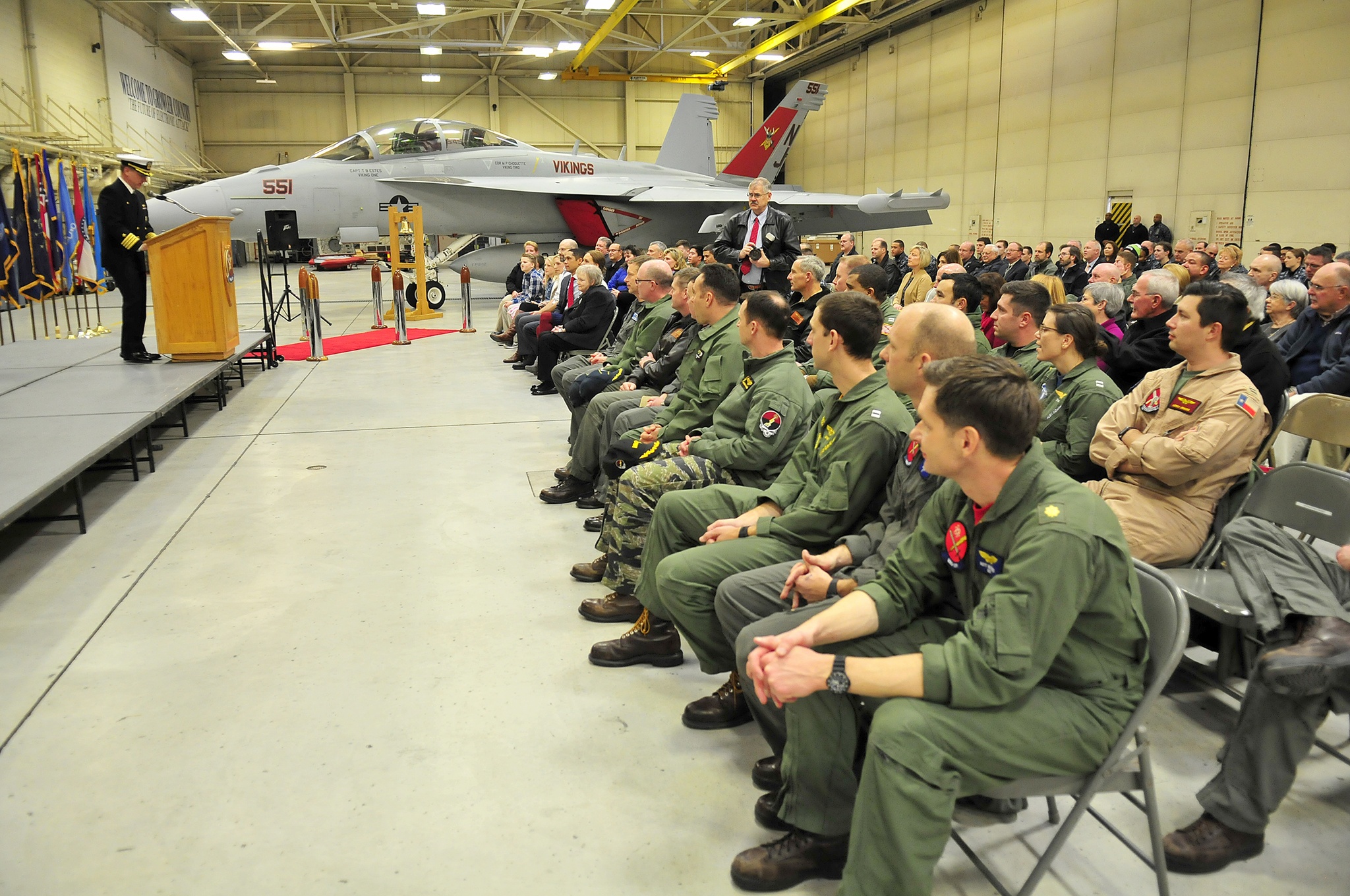Story by TONY POPP
NASWI Public Affairs
Joseph Farina received a surprise retirement party at Naval Air Station Whidbey Island Jan. 13.
It was far from a typical celebration, however. More than 200 military and civilian personnel from the electronic attack community gathered at Electronic Attack Squadron 129 to retire Farina, who was surprised with an Honorary Naval Aviator Award from Chief of Naval Operations Adm. John M. Richardson.
Capt. Trevor Estes, VAQ-129’s fleet replacement training commanding officer, pinned the wings on Farina on behalf of the CNO. As Naval Air Station Whidbey Island’s Northrop Grumman senior logistics field representative, Farina becomes the 29th Honorary Naval Aviator to joins the ranks of such notables as legendary entertainer Bob Hope, Adm. Arleigh Burke and Gen. “Jimmy” Doolittle.
“It was the biggest surprise of my life,” said Farina. “I was stunned. My wife and I consider all the military men and women, civilians and contractors here part of our extended family. We’re proud of them and I thank them all. … I’m honored and humbled.”
Farina has been a mainstay for Commander, Electronic Attack Wing for both the EA-6B Prowler and EA-18G Growler. He spent 42 of his 53 years with Northrop Grumman providing logistical support to the U.S. Navy.
“Farina’s personal contribution to aerospace and aviation for over 53 years is nothing short of phenomenal,” Estes said. “His overall support coordination of Naval Aviation with the Operational Wing, Squadrons, Supply Department, NAVAIR (Naval Air Systems Command) and Northrop Grumman engineering/vendors has resulted in hundreds of successful squadron deployments scheduled worldwide.”
Farina came to NAS Whidbey Island in 1974 in what was supposed to be a temporary two-year assignment from the Lunar Module program in Florida. He was sent by the Grumman Corporation to specifically support the Aviation Electronic Attack community and particularly the EA-6B Prowler in its initial war-fighting suites known as the standard and expanded capability. His work ensured the fleet met the worldwide post-Vietnam, Cold War challenges.
Farina was the primary logistic interface between the Grumman/Northrop Grumman Corporation, Navy Supply, Naval Inventory Control Point, Naval Air Systems Command, appropriate program management agencies, Type Wing, all Aviation Electronic Attack deployers for East and West coasts and expeditionary deployments.
His support continued in the transition to EA-6B Improved Capability and eventually to the replacement aircraft, the EA-18G Growler, in 2009. He personally watched the flow of each aircraft component and weapons replaceable assembly as it proceeded in the logistics and repair process.
Capt. Scott Farr, commander of Electronic Attack Wing, U.S. Pacific Fleet, spoke at the ceremony, recalling Farina’s career milestones.
“Joe helped our community in over 195 EA-6B/EA-18G major carrier deployments to the Western Pacific and Indian oceans, Atlantic Ocean, Mediterranean Sea, and 52 EA-6B/EA-18G expeditionary deployments to Northern Italy, Turkey, Saudi Arabia, Afghanistan, Japan and Korea,” Farr said.
Farina was also involved in the Aviation Electronic Attack presence as part of the Forward Deployed Naval Force in Japan where VAQ-136 flew the EA-6B and now VAQ-141 flies the EA-18G.
Farr also noted Farina’s support during many contingency operations as well as combat operations during eight presidential administrations. Naval aviation operations included support of Arab/Israeli conflicts, Mayaguez, Iranian hostage, Libyan Freedom of Navigation engagements, former Republic of Yugoslavia/Serbia, and today’s continuing conflicts in Iraq, Afghanistan and Syria.
As site leader these four decades, Farina has promoted the transition and enthusiastically attended over 200 CVWP ceremonies, including the change of command for 24 Electronic Attack Wing commanders, 32 VAQ-129 Fleet Replacement Squadron commanding officers and numerous Fleet squadron commanding officers. He was also involved in the planning and execution of the EA-6B Prowler Sundown celebration, marking the end of an era in Aviation Electronic Attack.
“No AEA squadron has missed an operation or combat sortie during his four decade watch,” Estes said.


